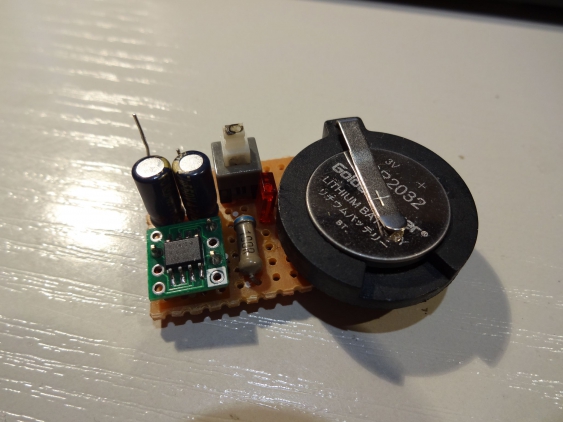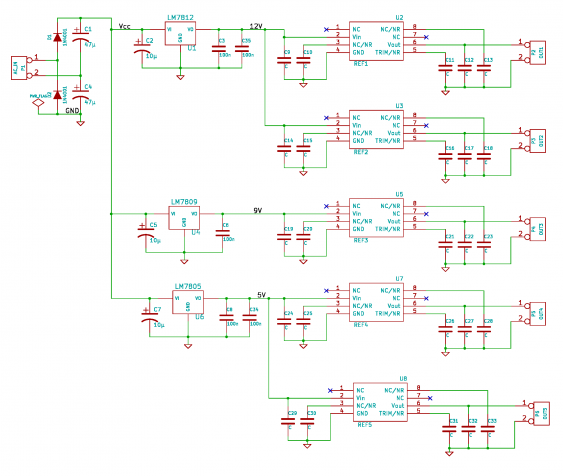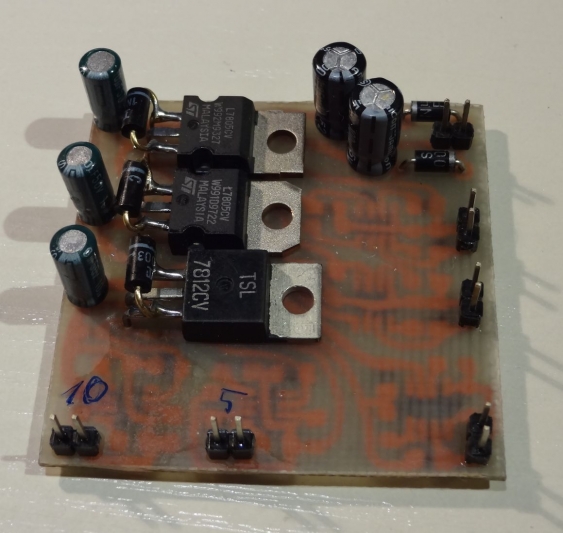« wireless power - battery under-voltage lockout with multiple cells
| Main |wireless power - status update »
Building a multi-voltage reference for my DMMs
A while ago I saw in the Dangerousprototypes forums a nice project: MrRef. Its a small voltage reference, intended to verify that a digital multimeter is still within its spec. Normally one would use either a real high-precision meter (like the Agilent 3458A) or a really good, calibrated voltage reference. But these are not exactly cheap, and probably overkill for a 50$ (or cheaper) multimeter. So matseng took a not so expensive voltage reference (a MAX6350, but it onto small breakout board, together with 4 batteries, and had something which is at least more accurate than the normal hobbyists multimeter.
Seeing this I did something similar - but I used a REF5020 from TI instead:
but it was not as accurate as I would have liked (the initial accuracy is 0.1%), and the 2.048 Vv output voltage meant that its just over the range for a 2000 counts multimeter (so it read 2.05).
So when I bought a new multimeter last fall (two UT61E actually), I looked into building a new, more accurate reference, with a wider range of voltages.
I know that there is e.g. the PentaRef available, but it costs more than my multimeters do. So I looked which voltage references are available, with a good out-of-the-box accuracy. When doing that I saw that there is kind of a standard chip layout for these references (at least as long as they are in SOIC-8 packaging). So it occurred to me that I could build a universal board for multiple references, and then populate them with what I would need. So the ‘MultiRef’ project was born.
The idea here was to get a broader range of voltages, to be able to see whether the linearity of the meters is OK, and to be able to verify at least two ranges. Since standard references with high accuracy are available in a range of about 1.25V up to 10 V, this seemed feasible.
After collection the data sheets of many of these references in SO8 package, I saw that they basically might need up to three out of four possible external capacitors:
- on the input voltage
- on the output voltage
- and two different locations for a noise reduction capacitor
All chips seem to handle ceramic capacitors, just the values vary. So my schematic incorporates an imaginary generic voltage reference, equipped with these four capacitors:
Based on the voltages I originally planned, I added several different voltage regulators. Any reference under 4 V should be able to use a 7805 for its supply, a 5V reference would need about 7 V, and up to 10 V references would needs 12 V. I grouped multiple references together because I did not want to use so many regulators. (I looked for what I had available, and it was mostly 78xx-style regulators) It would be possible to run most references from a single 12 V supply rail. But then e.g. a 1.25 V reference needs to drop more than 10 V for regulation, which could lead to significant warming (depending on the supply current of the reference). So its better to have a supply voltage that better matches the output voltage.
Since I wanted to have a 10 V reference, using a battery directly was not possible. And to reduce noise I didn’t want to use a step-up converter. So I planned to use a 9 V AC power supply, using a simple voltage doubler.
So in the schematic, one can see the voltage doubler with smoothing capacitor, followed by the set of voltage regulators. After that the voltage references are assigned to the different regulators.
In the beginning, I wanted to have 10 V, 7.5 V, 5 V, 2.5 V and 1.25 V as outputs. So I planned 12 V for the 10 V and the 7.5 V reference, 9 V for the 5 V reference and a 5V rail for the rest.
But then I realized that a reference just above 2 V might be handy - the UT61E goes up to 22000 counts. So the 2.5 V output is too high, and the 1.25 V one is just at half of the range. The original 2.048 V I had before were just perfect for that meter, it was just not accurate enough. I should have thought of that earlier on…
So I added this voltage in, and moved the 7.5 V reference out. It was the one which gave the least amount of additional information (both 5 V and 10 V are always in the same measurement range for all of my meters, and cover the 20V range nicely). But I had finished the PCB already at that point, so I just changed the 9 V regulator with a 5 V one. This meant that my PCB now has two 5 V regulators, one with a single and the other with two voltage references.
Selecting references
Speaking of references: I selected the ones I could get hold on, and then looked for the best initial accuracy I could get. Since I have no way of measuring the initial voltages, this was important to me. So maybe the references I selected could be better in terms of drift and noise, but my meters are not so accurate that this should matter.
So I selected these references:
| IC | Voltage | Initial Accuracy | Drift (ppm/°C) |
|---|---|---|---|
| REF102CU | 10 V | 0.025% | 2.5 |
| ISL21009BFB850 | 5.0 V | 0.01% | 3 |
| ISL21009BFB825 | 2.5 V | 0.02% | 2 |
| ADR4520B | 2.048 V | 0.02% | 2 |
| ISL21090BFB812Z | 1.25 V | 0.03% | 7 |
There are some different references, sometimes in other packages, but that’s as good as it gets. Together these references cost about $30, depending on where you buy them.
Building it up
The PCB is a mixture of SMD and PTH components. For the 12 V supply voltage I had only a LM7812 in TO220 package available, but nothing in SMD. So I decided to to the whole power supply part in through-hole style, and the part with the voltage references in SMD. This also split these parts up between different sides of the PCB, allowing to get it a little bit smaller. In the end I managed to fit it onto a 4x4 cm PCB. For all the caps which might be (or not be ) placed I used 1210 footprints. This allows placement of caps up to 10 µF, but also down to ones in 0805 size if needed.
I also added a small adapter consisting just of a DPDT switch, which I use to quickly reverse the voltage. That way I can check both polarities and see whether the rectifier works properly.
How are the DMMs doing?
Having build everything up (one of the references took three weeks to arive…), I looked at all my meters. Good news is that they are all within their spec. One of the cheaper ones is off by about 0.8 %, but this is still OK. I will repeat these measurements about once a month, and see how they drift over time (the older ones should not drift at all, since they are several years old by now).



